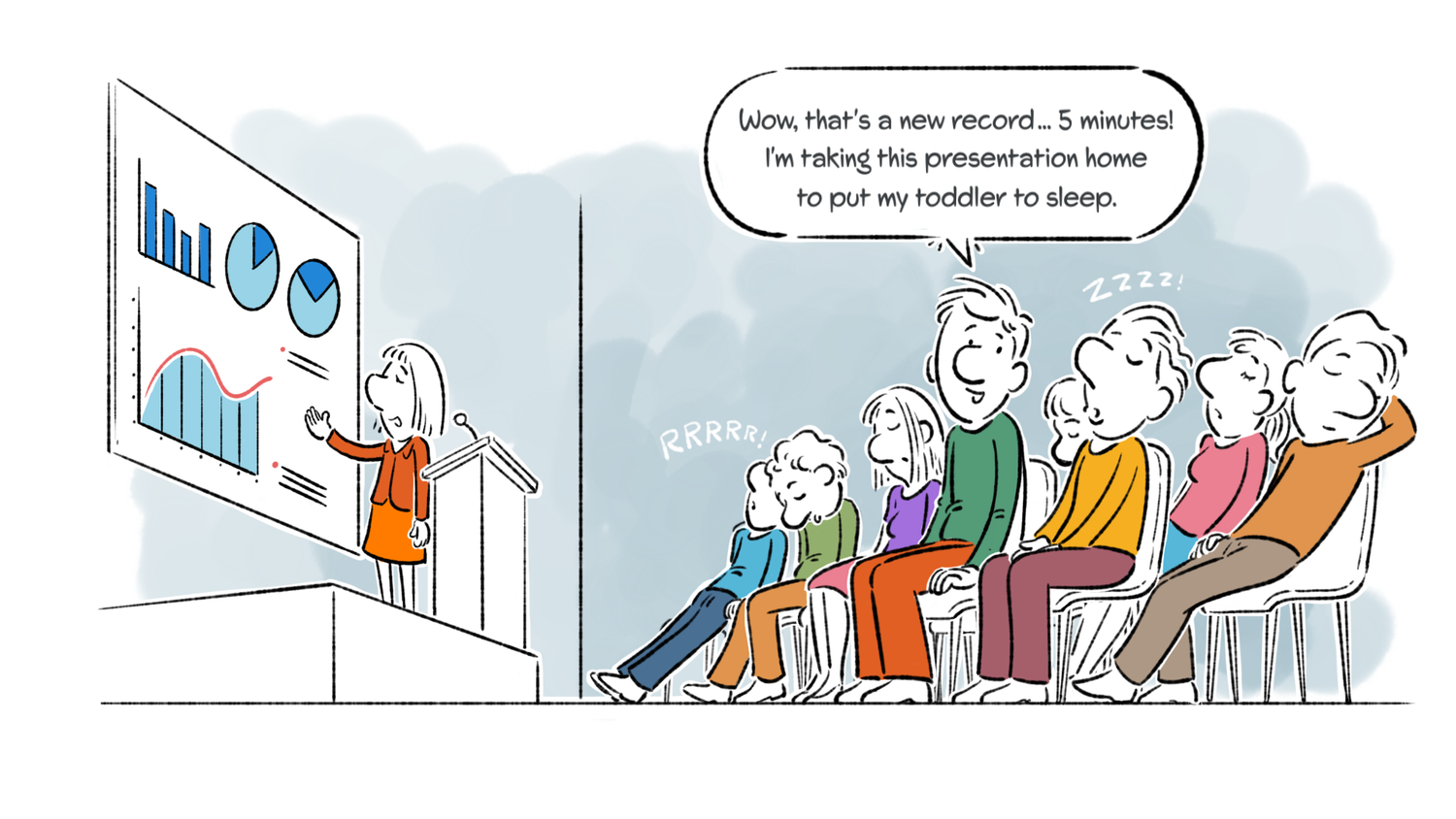
Konstantinos Papakonstantinou
Chief Story Architect @ Boost Win Rate | www.BoostWinRate.com
Step by step how-to leverage the power of video storytelling in enterprise sales & marketing
Q: Everyone talks about the power of storytelling but there seems to be a lot of confusion… what IS enterprise storytelling?
Many sales and marketing leaders I’ve talked to use “storytelling” to mean: building a narrative for presentations. So enterprise storytelling often devolves into rearranging powerpoint slides. But that’s NOT the reason why your audience’s eyes gloss over your presentation. It’s because the content doesn’t resonate.
Storytelling is about telling an actual story that brings a point to life and helps your audience understand it (and ideally see it, or even feel it!).
For example, you may give a presentation where you claim that you care a lot about the quality and dedication of your customer service… but what does that really mean? It sounds silly, but I see problems like this in almost all corporate presentations. We make claims and don’t bother to explain or back them up. We assume our audience is thinking what we’re thinking, which couldn’t be further from the truth.
Imagine instead if you shared the story of a client that experienced trouble with your solution, and your team spent all night with them to rectify the situation. The more specifics you include the better. You don’t want your audience to fill in the blanks. Help them visualize the situation and feel the relief your client felt, when they saw you had their back all the way.
Enterprise storytelling is all about sharing stories with your clients in every setting possible: in your social media, your white papers, your videos, your sales pitches. Anywhere you make a claim and want prospects to listen.
Don’t start with claims, start with stories to make your points heard and understood. Claims invite pushback in the minds of your audience, whereas stories draws them in and the information comes along for the ride.

Q: So how can enterprises actually use storytelling?
Your storytelling journey should probably start by studying your Buyer’s journey. You can identify all the critical touch points and incorporate stories along the way.
For example, at the top of the funnel maybe you’re creating thought leadership or educational content. Make your claims more digestible and your points more memorable by starting with stories. We love stories, especially if they reference competitors, partners, or other people we recognize in business. We want to hear about their business struggles and how they tackled them.
— KP
The beauty of it is, at the top of the funnel you don’t even have to limit yourself to your clients. Just talk about relevant business problems you can solve, and how you’ve seen others solve them. You don’t want to talk about your solution or your company yet. It’s more about the storytelling and staying relevant by addressing top-of-mind questions for your audience.
Over time and the more they consume your content, Buyers will get to know, like, and trust you. And eventually – when the need comes up – they will reach out without having to do any research and explore competing solutions. You will be the de facto answer to their problems.
Q: Once you’ve mapped out your Buyer journey, WHAT stories do you tell? Where do you find the stories, and how do you prepare them? I think I’d be caught like a deer in headlights if I had to tell a story to make a point…
And you’re not alone. This is actually the biggest problem and why most enterprises haven’t been successful at using storytelling in their content and pitches.
Over time, you want to shift into a “storytelling mindset” so you start spotting stories as they happen in your everyday life. You don’t need big stories, just simple stories that you can tie back to a business point.
— KP.
But when you’re starting, of course it’s more difficult: you have to actively seek out stories and extract them from your sales and marketing leaders.
Usually, all it takes is listening in on sales or marketing meetings, or interviewing some of your leaders. As long as you ask the right questions – it’s not the “why” type questions but the “what” or the “how” that get the best stories – you will get to the kernel of a story, and then you can dig deeper.
Q: But even with stories in hand though, there’s a big problem with delivering them. Many of us aren’t natural-born sit-around-the-campfire storytellers. We get on Zoom calls or give live presentations and freeze up!
Indeed, improving your “camera readiness” is very important. The good news is, I’ve found this to be an easier problem to fix than you might think. All it takes is a bit of preparation and coaching. The thing to remember is that you’re not going for Hollywood production quality, just good enough to look polished in front of your clients.
This typically involves making sure your background looks nice and you have a good camera and lighting. Then, you need a half-hour coaching on the basics of presenting on camera, which involves facial expressions (tip: you can never smile enough!) and hand gestures (tip: use your hands to show how many points you’re making).
With a few tips and after watching a few video examples, you’re 80% there. And over time you’ll fill in any gaps. All you need is a bit of preparation to develop the right stories, delivered the right way, at the right time.
Q: What are some concrete examples of how enterprises are using storytelling today?
There are 3 major ways storytelling is helping enterprises build trust with an audience of prospects and boost their win rate with big accounts.
— KP.
First, social media and thought leadership video content can be transformed when your leaders open their videos with a story. The marketing department can lead the effort with executive interviews to help leaders identify stories to tell and business points to make, and then create a content production plan. For those comfortable on camera, they only need the topic and a few bullet points. But quite often we see that a full script is required. The key here is to coach the speaker on how to read a script on camera and look engaging. It’s easier than it sounds and all you need is a good teleprompter app complemented by good, conversational script writing.
Next, sales pitches benefit tremendously from storytelling. Whenever you put a claim on a slide, preface it with a relevant story. If the point is important and you need it to stick, i.e., get accepted and remembered, then you need to accompany it with the right story. So go through your pitch and identify “story points,” then extract practical stories through an interview process, convert them into a rough script, and roleplay it with the AE delivering the pitch.
— KP.
And finally, you can use storytelling in short videos that you can play during finalist meetings. These videos are great for creating common ground and demonstrating a deep understanding of your client. These videos can also be used to arm your champions with something they can share throughout the client organization. Don’t rely on your champions to fight your battles. Arm them with storytelling videos to get your message across.
Q: Sounds like storytelling can be really powerful in an enterprise setting… why aren’t more companies using it?
In fact, many enterprises have already tried storytelling, but got nowhere. That’s because they hired an enthusiastic storytelling coach to run a hyped-up workshop and energize the troops.
The problem is: sales workshops create excitement but there’s no follow-through. And it makes perfect sense. No 1-2 hour workshop can turn your team into storytelling machines. How are Sales Leaders to know WHAT stories to tell, WHEN, and HOW? Those are the 3 key missing ingredients. The result? Temporary excitement but no execution.
— KP.
You need someone to do the heavy lifting and:
Map out your Buyer’s journey and critical touch points that can benefit from storytelling
Extract practical & engaging stories through an interview process (and refine them)
Coach and prepare those delivering the stories
Funny thing is, most enterprises already have all the raw materials – white papers, blog posts, videos, content research and planning resources – so it’s just realizing that stories can supercharge their assets, engage more audience, and get more mileage out of them.
Enterprise storytelling is very powerful in engaging your audience and increasing your win rate
First, map out your Buyer’s journey and identify key “story points” along the way
Next, extract practical & engaging stories through an interview process
And then, improve your team’s “camera readiness” and coach them on delivery
Thank You For Your Vote!
Sorry You have Already Voted!
